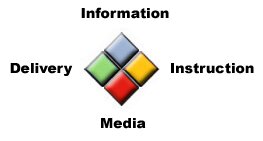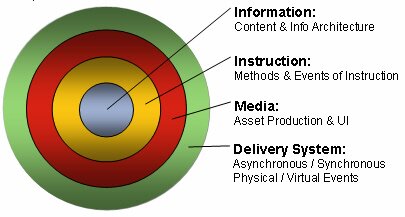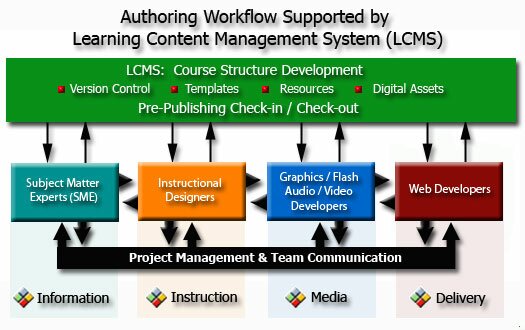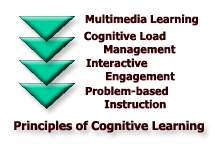|
 Design Process > Process Paradigm Design Process > Process Paradigm
The Process Paradigm
|
"A paradigm is the fundamental lens through which we view our environment. The paradigm that governs our thinking about a given system is the theory that determines the invariant features that shape the system and defines how to succeed within the system. Usually a paradigm is so ingrained, so rooted in our familiar sense of the way things are, that we hold it unconsciously, without either choice or deliberation."
John Tagg
|
A paradigm is a framework of perceiving, thinking and acting. It is a cognitive structure composed of aggregated concepts, values, beliefs and assumptions that organizes how we perceive, how we think and how we act — by, consciously or unconsciously, supporting rule-governed behavior.
Cultural-social institutions utilize and promote paradigms in endeavors as diverse as science & technology, economics & commerce, business & multi-national corporations, organized religion & personal spirituality, family & marriage, government & citizenship. Each of these examples use a framework of unwritten rules to direct behavior and establish social expectations. The word "paradigm" was described by a CNN survey as one of the most overused words of 2004. This is because of the tremendous rush of cultural, social and technological change, and emergent transformations taking place. We have so little language to adequately describe, or become self-aware of the cultural forces which are driving us.
If our assumptions, beliefs and values are unconscious, then a paradigm will function like superstition: a mind-set, or way of perceiving, that anchors a rigid view of the world, and thus fixates rigidity in our thinking and behavior. It can create an illusion/delusion that there is only one "right way" to perceive, think or act. However, if we are conscious of our concepts, assumptions, beliefs and values, then we can apply a paradigm as a mental tool: a set of rules or mental models that we use so long as they adequately express truth, value, and integrity. They are rules, models, frames of perception and mind-sets that are to be surrendered when they no longer serve us. A mental model which serves us well at one developmental stage can be an obstacle in another stage if no revision, updating, reframing or cognitive maintenace occurs.
Some of the best examples of paradigms are found in science, where a paradigm is used as a framework of ideas applied to a particular topic for explanation, prediction, problem-solving or methodology. In the constantly evolving fields of science everyone understands that these rules of explanation and method are transient and subject to ongoing revision and improvement.
Joel Barker has defined paradigm this way:
"A paradigm is a set of rules and regulations (written or unwritten) that does two things: (1) it establishes or defines boundaries; and (2) it tells you how to behave inside the boundaries in order to be successful."
Joel Barker, Paradigms: The Business of Discovering the Future (1992), p 32.
Barker further points to the following terms, which he arranged on a spectrum from "challengeable to unchallengeable." He believes these are subsets of the concept of paradigm:
"Theory, model, methodology, principles, standards, protocol, routines, assumptions, conventions, patterns, habits, common sense, conventional wisdom, mind-set, values, frames of reference, tradition, customs, prejudices, ideology, inhibitions, superstitions, rituals, compulsions, addictions, doctrine, dogma" (ibid., pp 35-36).
The idea behind a paradigm shift is that the rules of a "game" change as a new mental model becomes available. With a new mental model comes a consequent, often dramatic, transformation of perception, thinking and action.
A Three-Part Process
The Cognitive Design Process is offered as a mental model for planning and evaluation of the instructional design process. The heuristic device has three parts:
- Performance Environment Principles
- Design Element Principles
- Cognitive Learning Principles
|
Each part involves analysis leading to problem-identification, and instructional decisions leading to solution design — strategy, tactics, and methods. Here is a graphic portrayal of the model:

This model provides an integrated framing of instructional development requirements:
- Define the goal & content of instruction,
- Design the instruction & learning process — appropriate to audience, resources and environment,
- Develop the needed media elements to optimize communication and learner interaction, and
- Deliver instruction effectively using appropriate technology infrastructure and environmental controls.
Design of Performance Improvement Environments
Performance problems are not always "training" problems.
- Many problems are due to lack of timely information and communication.
- Other performance problems are due to motivational issues.
- There may be hidden organizational dynamics or history which establish structural barriers or impediments to, or sabbatoge of, the desired performance.
- Many task learning problems cannot be abstracted away from the performance environment into a classroom — you simply cannot learn the skill in a classroom. You must learn it on the job in the context of relationships, demands and tools of workflow.
A comprehensive approach to solving performance solutions — that seeks to address all of these learning needs — has been described as "building a Learning Organization." This is a model of organizational learning that addresses individual, team, and enterprise learning needs in a dynamic and unified way. We believe that the roadmap to achieve this goal is through design of Knowledge Management, E-Learning and Performance Support as structurally integrated performance environments through technical infrastructure, and enterprise culture and best practices.
A performance problem may be the result of a knowledge deficit, a skill deficit, a motivational deficit, environmental barriers, or a combination of those factors. While learning may be an essential component of a solution, traditional classroom training may not be an adequate delivery system or a sufficient strategy to deal with these deficits or barriers.
Learner needs analysis must be carried out within the context of the performance environment. Environmental analysis (behavioral & cognitive) is an essential component of learner or audience analysis.

There are three distinct performance improvement environments that deliver learning solutions in the modern enterprise: Knowledge Management, E-Learning, and Performance Support. These are structures of technology infrastructure, enterprise culture and best practices dissemination.

Knowledge Management provides an information-rich environment that allows information access, information-on-demand, knowledge capture and transfer, and establishment of a collaborative knowledge-sharing community.
The technology infrastructure includes internet, intranet, email, workgroup networks, relational databases, document management systems, content management systems, customer management systems, workgroup collaboration software & environments, audio-video phone conferencing, etc. New technology is constantly evolving to strengthen the data, information, and knowledge sharing components of KM.
The keynote of these Knowledge Management solutions is "information" — that is, to provide the right information, at the right time, to the right people. Collaboration is a major premise of Knowledge Management solutions.
Both E-Learning and Performance Support build on this collaborative technology infrastructure.

E-Learning provides a "blended learning" solution — that unites traditional classroom training with numerous other delivery formats, such as self-paced Web-based Training, online virtual classroom, simulation, peer-to-peer mentoring, etc. The keynote is "instruction" — meaning not just information presentation, but interactivity, guidance, reinforcement, demonstration and practice that strengthen learning.
The technology infrastructure includes all technology-based training tools — whether in a classroom, at a workstation, or online multimedia. E-Learning infrastructure includes Learning Management Systems and Learning Content Management Systems (software), classroom technology-based instruction, Internet, intranet, and CD-ROM/DVD delivery systems. Human resource development is a major premise of E-Learning performance solutions.

Performance Support provides task support in the performance environment in order to strengthen transfer-of-learning. The keynote here is "guidance". Historically this area of "guidance" has been the domain of team managers — who provide mentoring, role-modeling, inspiration and leadership as part of their management-supervisory role. These techniques have often lacked an understanding of the principles of learning or instruction, or an understanding of the core competencies (skill, knowledge and attitudes) that are essential for the worker's duties.
Performance Systems (PS) include management skills such as coaching, mentoring, staff selection, and design of incentive systems; and metacognitive skill training (related to motivation, attitude and task monitoring), and software supported task guidance (such as EPSS, Wizards, Help Desk Resources). The technology infrastructure of PS utilizes the collaborative environment established by KM, and the personalized learning environment used by E-Learning, and then adds tools for direct performance support and guidance.
Empowerment of the individual is a major premise of Performance Support solutions. The paradigm shift that PS offers the traditional team manager is a move from "productivity" to "performance," from "worker" to "continuous learner," from "supervisor/manager" to "coach," and from "activity" to "learning opportunity."
Motivational deficits relate to intrinsic as well as extrinsic motivation. Motivation analysis and design takes into account emotional states and attitudes that effect learning. It emphasizes metacognitive skill development as an intervention strategy that can take place in any one of the three performance environments.
Engineering performance improvement solutions requires a combination of delivery systems to Inform, Instruct and Guide. Each of these performance improvement environments link people, organization and knowledge together. These delivery system environments when integrated provide the essential infrastructure for building a "learning organization" — the big picture definition of organizational learning needs: enterprise, team, individual.
Analysis and Design of Learning Structures
There are four design elements that compose an E-Learning product or activity: information, instruction, media and delivery system. The integration of these elements allows a viable and balanced E-Learning experience to be provided.

An E-Learning project begins with an overall sense of how a learning need is supported by the gestalt of the design elements. Consideration of one element immediately triggers consideration of the other three design elements. An E-Learning project can fail if there is weakness in any one of the design areas because it undermines the integrity of the learning structure being created.
One way of understanding how an E-Learning product can achieve structural integrity is to see the design elements as nested within each other. Each succeeding layer becomes the instrumental carrier of the preceding learning structure.

- Delivery System provides the physical or virtual mechanism of presentation. It defines a realistic and appropriate physical environment & technology implementation. The system supports asynchronous and synchronous events, and physical or virtual events (in order to overcome time and place limitations). Delivery system infrastructure determines which technology options are available for instructional media and instructional method. By establishing a physical and virtual space for learning experiences, a "blended" learning approach can be used to integrate a wide variety of learning activities and media.
- Media provides the graphic and text packaging for message presentation. It is only effective if it serves as a carrier of the instructional method, and is functionally appropriate to the technology environment. Aesthetic enjoyment is an important aspect of perception and communication. The production of media elements (whether graphic, text, animation, audio, video, etc.) each require substantial technical skill and attention to detail.
- Instruction is accomplished only if events of instruction are presented effectively. Appropriate instructional methods are selected based on the audience, the objectives to be achieved, and the technology options which are available. Instructional message and method drives the choice of appropriate media.
- Information refers to the unique content of the communication message. The information architecture organizes access, meaningfulness and usability for the audience.

As we use this planning paradigm, we ask the following key questions to more fully define the desired learning process:

Information is learning structure based on content definition.
- What does the learner desire to learn?
- What does the enterprise need for the learner to learn?
|
The process begins with an informal sense of the needed subject-matter topics and an inquiry for the appropriate Delivery System and Instructional methods that can present that information to the learner.
The earlier the Delivery System requirement is clarified, the better it is for the content definition process. The decision about Delivery System will impact the process of content preparation and writing style: whether for traditional classroom, self-paced WBT tutorials, virtual classroom, CD-ROM/DVD, print — or some combination of all these modes as "blended learning."
Maturing the content definition proceeds through task analysis (identification and validation of the subject matter), leading to the preliminary definition of instructional objectives. This work validates the needed content to come from the subject matter experts (SMEs). Usually the instructional designer conducts task analysis with collaborative input from the SMEs. This process of content analysis enables the instructional designer to gain sufficient understanding of the subject matter to engage in the later steps of instructional design and development.
Content definition in the early stage is finalized through the work of SMEs getting content drafts ready to hand to instructional designers and developers.
Job analysis and competencies specification may also play an important role in the content specification, as these may ultimately relate to the success of transfer-of-learning.
The content definition is fully matured when the instructional designer completes an information architecture treatment that differentiates the content layer from presentation, navigation, and meta-tag layers. Information architecture defines content structural organization in topic hierarchy; identifies content types, navigation and presentation formats; selects naming conventions and content meta-tags. The identification of content types includes: procedures, concepts, facts, processes, and principles. Preliminary instructional objectives are written in a way that takes these content distinctions into account.
Instruction is learning structure based on the pedagogy definition — it includes instructional decisions related to strategy, methods, and materials.
- How can the subject-matter best be taught?
- How can the most meaningful and efficient learning experience be designed?
|
The process begins with long-range goals, the content portfolio (ideally with an information architecture treatment), and the preliminary instructional objectives, and submits these to the instructional design process — particularly Gagne's Nine Events of Instruction.
Clark's Four Learning Architectures (Receptive, Directive, Guided Discovery, and Exploratory) provide a learning theory rationale for composing a "blended learning" strategy. The different architectures suggest different ways to organize lesson content, whether and what kind of practice is included, the value of making mistakes during learning, and the opportunities for the learner to control the learning process. The different Delivery Systems modalities which constitute a "blended" or "hybrid" learning approach reflect the kind of instructional choices that the designer believes is appropriate (most effective and efficient) for a particular audience.
Merrill's Five Star Instruction has identified five phases of instruction and optimum learner experience: problem, activation, demonstration, application and integration. This format provides a comprehensive design model for instructional strategy definition.
Specific instructional methods or technique are crafted to achieve each of these broad instructional strategies. Once instructional method has been defined, then the optimum instructional media can be selected as instruments for these methods.
Finalization of instructional objectives reflects the iterative process of refining instructional methods and the selection of instructional media. The instructional designer envisions the terminal behavior (performance) that demonstrates learning to mastery. Pre- and Post-test measures are defined which give the learning objective specificity. The interactive components, challenge questions, demonstrations, practice and quizzes are defined which give the learner an environment of active responding.
The instructional designer places the E-Learning experience within the context of Knowledge Management and Performance Support, and will use these resources as part of the instructional plan. The instructional designer understands that the adult learner brings valuable meaningful past learning to the new learning task, and will return to a performance setting where transfer-of-learning must occur (i.e., work, school, home, etc.).
A primary purpose in establishing a relationship to KM and PS resources is to have the learner experience the s/he is part of a learning community and to engage the learner in participatory, interactive, and collaborative communication within this community.
Media is the learning structure based on the definition of text, graphics, audio and video elements that support the learning objectives.
- How are the five senses to be optimally engaged in the learner's experience?
- What is the production process (manpower, expertise, tools and resources) required to develop these media?
|
Mayer's Six Principles of Multimedia Learning (multimedia, contiguity, coherence, modality, redundancy and personalization) are used as technical criteria for proper construction and presentation of media. The instructional designer holds to Mayer's "less is more" observation established by research on cognitive load.
Media are developed appropriate to the instructional objective and content type (i.e., procedures, concepts, facts, processes, or principles). Ideally key media will be related to demonstration and practice instructional strategies.
The Media production process is crafted in relation to the Instructional methods and the Delivery System infrastructure.
Delivery System is learning structure based on technology infrastructure definition.
- What will it take to present E-Learning content, instructional methods and media to the learner?
- What are the Delivery System requirements that will achieve the instructional objectives and be viable within resource constraints and project scope?
|
If the Delivery System infrastructure is not viable then the content objective must be re-evaluated. The development process may become so involved with Delivery System technology issues that resources for instructional development may be undermined. Too much emphasis on technology is a common, but troubling, imbalance. Defining the viability of the technical infrastructure has an immediate positive impact on the Instruction and Media design elements.
Once the workflow cycle has moved through Instructional development and media production stages, Delivery System issues become the central concern. The workflow task, then, is to complete all the Delivery System components needed for delivery of the instructional experience. During the implementation phase of project workflow, Delivery System logistics and quality assurance are the primary issues.
Cognitive Learning Analysis and Design
The principles of Cognitive Learning are applied to the Performance Improvement Environments, the key Design Elements, and the project management workflow in order stay "Learner-centric" — focused operationally and continuously on the cognitive issues of the learner.

The principles of Multimedia Learning are focused on planning and evaluation of text, graphic, animation, audio, and video elements of instruction to ensure they exhibit sensible presentation technique.
The principles of Cognitive Load Management are concerned with planning and evaluation of each unit of instruction (event, page, lesson, module, course or curriculum) to ensure that the learner's capacity to engage attention, retention, responsiveness, and transfer are not undermined by problems with Cognitive Load.
The principles of Interactive Engagement are deal with planning and evaluation of an active learning environment — to optimize information processing (encoding and retrieval) and interactivity, as well as learner control and motivation (metacognition).
The principles of Problem-based Instruction are particularly focused on planning and evaluation of units of instruction (lessons, modules and courses) to ensure that the learner is presented with meaningful and relevant learning challenges, and that the four phases of instruction (activation, demonstration, application and integration) are present.
Building Integrated Solutions: "Learning Organization" Roadmap
The goal of working with this Process Paradigm is not only to address the needs of the individual, but also to address team and enterprise learning needs.
Cognitive Design provides a roadmap for building a "learning organization" — that is, building an enterprise skilled in the ability to create, acquire, and transfer knowledge, and to modify organizational behavior to reflect new knowledge and insight. This is achieved by the following process paradigm:
First, by designing Knowledge Management, E-Learning and Performance Support environments to interface together and work synergistically. Through integration, a comprehensive enterprise solution can be built to improve learning, motivation and performance at every level of the enterprise.

Second, by clarifying learning delivery goals and methods. Informing, Instructing, and Guiding are distinct cognitive design challenges — that uniquely impact individual, team and enterprise dimensions of learning.

Third, by emphasizing that the highest value is based on "collaborate, develop and empower."
- Knowledge Management — establishes a collaborative knowledge-sharing community
- E-Learning — catalyzes human resource development through a variety of "blended learning" solutions, and
- Performance Support — empowers individual learners to monitor their own performance and access guidance systems in order to achieve higher degrees of productivity, task accomplishment and job satisfaction.

In this way, Cognitive Design Solutions provides a new paradigm of environmental design and delivery — attains new levels of individual and team learning — and achieves new levels of enterprise productivity and innovation.


|
|
 |
Process Paradigm |
 |
|
|



